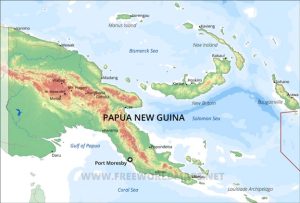60 Women in the Highlands of Papua New Guinea
Women in the Highlands of Papua New Guinea
Rural women in Papua New Guinea highlands suffer a derogatory village life. PNG one of the least developed countries in the world is made up of over 800 plus tribes scattered over the eastern half of New Guinea Island. Two physical regions contain different cultural and social attributes, Highland and Lowland.
 Physical map of Papua New Guinea from creative commons
Physical map of Papua New Guinea from creative commons
The highlands begin with an elevation over 5000 feet occupying the center of the country. The Bismarck range reaches over 14000 feet. At these chilly elevations, highland tribal cultures of hardworking hunters and farmers have grown to over two million people. Animosity between neighboring tribes is endemic and tribal wars are frequent
 Home in the PNG highlands, Photo by Rick Bein 1998.
Home in the PNG highlands, Photo by Rick Bein 1998.
The lowland people, subsisting on fishing and garden crops, are more laid back and less warlike.
Recurring tribal wars happen every five years or so as acts of vengeance and begin with a surprise attack raiding a village with stone axes, spears and bows and arrows. (In 2000 there were no guns on the island.) Few deaths occur, but enemy men and women are beaten, and raped. As a retribution between warring tribes, the weaker of the tribes negotiate with gifts of women or pigs to the stronger tribe.
In 1998 my wife, Maryellen was traveling into the highlands on a mission and at the first stop, a tribe of warriors entered the plane with paint all over their bodies. One of them sat in the seat next to her. He sat very stoic and took no heed of her. After a while, curiosity got the better of her and she asked if they were going to a “sing-sing,” (a dance competition created by the missionaries to substitute for war,) At first, he refused to answer, but she kept pestering and he suddenly stated, “Going to war”!
 “Sing-sing” competition Madang, PNG. Photo by Rick Bein 1996
“Sing-sing” competition Madang, PNG. Photo by Rick Bein 1996
(We learned afterward that when tribes prepare for war, the warriors believe that speaking to women will deplete their fighting resolve.)
At the next stop the tribe got up, collected their spears, bows and arrows from the attendants and got off the plane.
In years past, the war would have involved a long hike over the mountain before surprising the enemy tribe. Now with modern technology the price of airplane tickets was no obstacle, and the fighters would not be worn out from the hike.
Women throughout the country are subservient to the men, but, in the highlands, woman experience more hardships. Here women are considered property and forced into hard labor, doing most of the farming and carrying heavy loads.
 Highland woman and the family garden. Photo by Rick Bein 1999.
Highland woman and the family garden. Photo by Rick Bein 1999.
In the highlands women are beaten by their husbands on a regular basis and those that resist are severely punished or even killed. During their menstrual period they are forced to sleep in the pigsty. Women are so submissive to this treatment that beatings are considered acts of love. Women compare cuts, bruises as measures of how much their husbands care for and love them.
One woman, from the eastern Highlands had enough. Her drunken husband had his knife out and was going to kill her. Being somewhat more agile than he, she grabbed a kitchen knife and killed him!
She knew she would be severely beaten and killed once the rest of the tribe found out. Running away was her only option.
She had a small amount of money and boarded the local bus before the village men could catch her. They were certain to come on the next bus. The bus went to Lae the regional capital. She went directly to the police and told them what she had done.
She knew there was no death penalty, and the maximum life penalty was 2 years. The police locked her up and held her until there was a trial.
Meanwhile the tribe caught up to her at the police station and the police blocked them. The judge declared guilty and placed in jail for 2 years. That was not enough of a penalty for the tribe, and they still wanted to kill her.
Once her two years, free room and board was up, she still had to evade the tribesmen who knew when she would be released.
The nuns at the local Catholic convent heard of her plight and arranged for a parole about a month early. They kept her in their confines waiting until there was a safe option.
Maryellen had been volunteering with the nuns and became aware of the woman’s predicament and spoke to some Australian friends who suggested giving the woman a pair of rabbits and to immerse herself into the slums of the city of Lae.
Maryellen bought two rabbits and a cage from the Australians and gave them to the woman. She lost touch with the woman at that point.
Two years later while we were in our final stages of our time in Papua New Guinea, we were shopping in the open market in Lae, a strange woman came up and hugged Maryellen. “Who are You”? she asked. The woman answered, “I have 40 rabbits now, thanks to you so much!”


